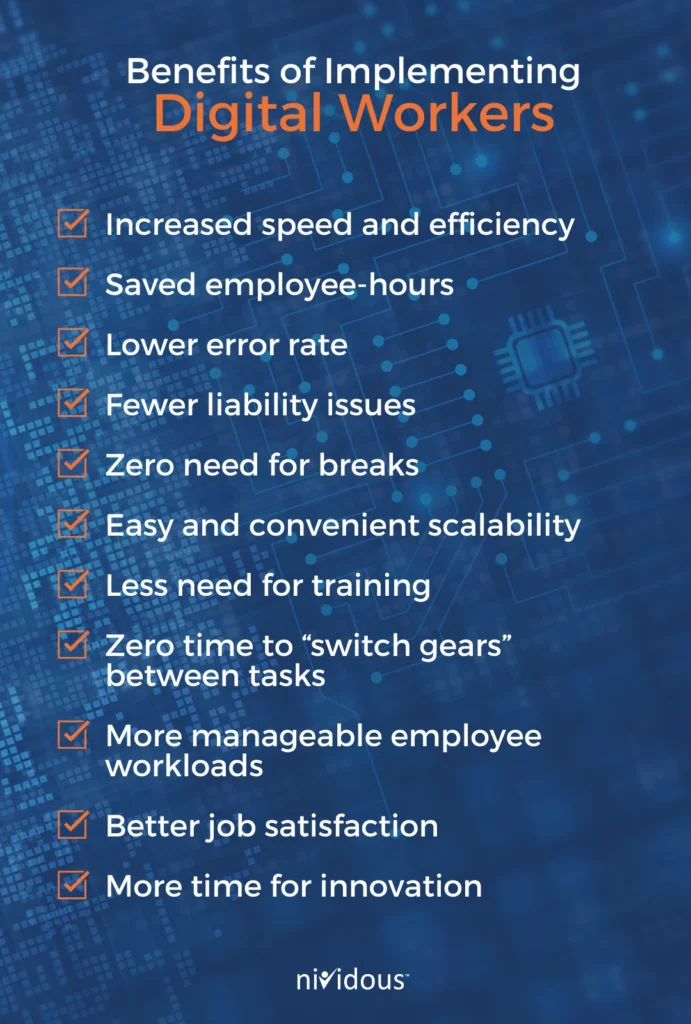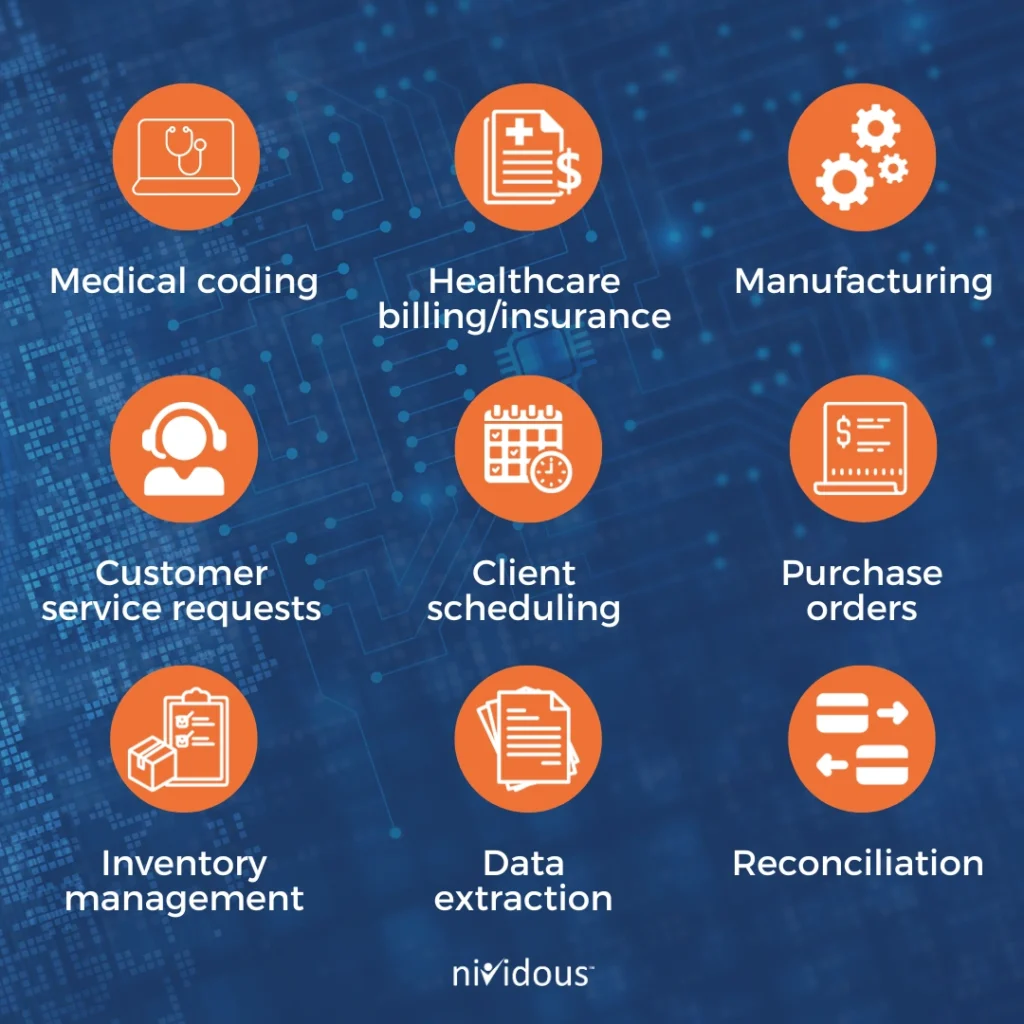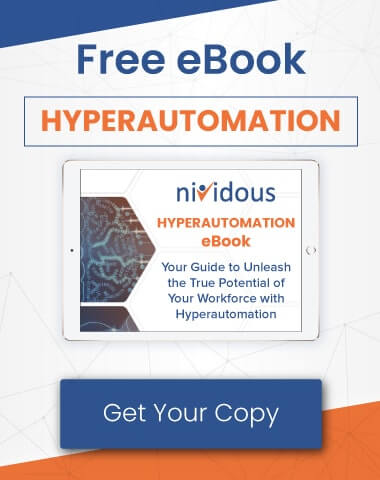AI and automation are truly exploding in the business world these days. Everywhere you turn, you hear of companies implementing automation solutions and using AI to streamline and optimize their operations. One term you may have heard thrown around is digital worker.
If you’re new to automation—or ready to jump in with both feet and start using digital workers in your own business—it’s a good time to brush up on the terminology and use cases you may encounter.
Below are some basics about digital workers, along with several suggestions of how you can optimize the way your company works with this rapidly evolving technology.
Interested in “hiring” a digital worker for your company? Let Nividous build your custom solution. Request a demo here.
What could you do with a digital worker in your business?
What is a digital worker?
The term digital worker might evoke many different thoughts so, to be clear, we will provide our definition. The modern definition of a digital worker is a piece of software that accomplishes specific tasks and completes processes.
Technically, any kind of automation could be described as a digital worker.
Think of a digital worker as a colleague who resides completely within the computer realm. The digital worker will work to make your job easier, faster and more streamlined To get the most out of digital workers, you will need to have clearly defined processes and roles. Additionally, you will need to understand which tasks in a process will be assigned to, and completed by, each role.
Some people consider digital workers to be the same thing as bots. Bots, after all, are also pieces of software that automate certain tasks, but there is a fine, nuanced difference between the two.
One bot can be trained to accomplish several different tasks, such as checking emails or sending out automated progress reports. These tasks may affect a dozen or more different workflows and interact with several separate human employees. Therefore, during its day to day activities, one bot could function as numerous different types of a digital worker.
Conversely, one RPA bot may be trained to perform only one mundane task, whereas a digital worker may be able to access entire frameworks and make intelligent decisions similar to a human.
For our purposes at Nividous, we consider a digital worker to be any combination of automation technologies put together to complete a process. That may (and likely will) include some number of bots, but it’s not necessarily a clear 1:1 relationship.
What are the benefits of using digital workers in your business?
Because digital workers operate with the precision and speed of a computer program—and often the intelligence of AI—they are capable of performing some tasks much faster and more accurately than human workers.
Some tasks will always require human oversight, and others will have no opportunity for automation at all. For example, physicians may use software to help quickly diagnose an illness in a patient, but they will also apply their own expert knowledge to judge if the diagnosis is correct.
In general, however, these are the benefits you can expect from implementing digital workers within your business:
- Increased speed and efficiency, especially for tedious tasks that deal with large volumes of data
- Saved employee-hours (and hourly wages that must be paid)
- A lower error rate, especially when combined with a human-led feedback loop that can correct the program to make sure the same error never happens twice
- A lower rate of liability issues due to the smaller potential for errors
- Zero need for breaks, lunchtime, or any other periods of rest
- Easy and convenient scalability
- Less need for training, besides the continual feedback loop (which should become less necessary over time as the program learns)
- Zero time to “switch gears” between tasks, like humans often require
- An easier workload for human employees
- Better job satisfaction for employees who no longer have to spend many hours completing tedious tasks
- More time for human employees to brainstorm innovative solutions and drive real progress

What are some examples of the work a digital worker can perform?
The answer to this question depends on the tasks you’d like to automate and the level of technology you wish to implement.
For simple tasks that don’t require complex decision-making skills or situational awareness, simple RPA bots will usually do the trick. Downloading email attachments, updating spreadsheet cells, and matching data across two different sources are some examples of what an RPA bot could accomplish.
If you want your digital worker to perform more complex tasks or automate entire processes from end to end, it’s likely you’ll need the assistance of artificial intelligence. AI can be used to create bots capable of making decisions and handling more complex situations.
For example, let’s say you want to automate your entire invoice payment process from start to finish. You’ll need an AI-backed digital worker that can:
- Open vendor emails
- Download invoices
- Read and parse data from documents that may or may not have a standardized format, or extract data in the case of unstructured source documents
- Input the new data into your central system
- Validate that information against your internal records from other relevant systems
- Present data to all concerned parties to provide internal approval
- Connect with the vendor’s payment account
- Shift funds from your account to your vendor’s
- Perform any account authorizations your bank may require
- Verify that the transaction is correct
- Update your records to show that the payment has been made
- Check for confirmation that the vendor received the payment
- Identify potential disputes if the vendor believes the payment was incorrect
Invoice payment is a complex, multi-step process where several steps might not be as cut-and-dry as a computer could normally handle. It’s these end-to-end business processes where AI-backed digital workers can truly shine.
Some other common examples of processes you could automate across a variety of industries include:

There are far more applications where digital workers could be successfully used; if your company has a particular pain point you’d like to soothe, chances are good that there is an automation solution that can take care of the issue.
Another term you may have already begun to hear is digital transformation.
As you begin your journey toward automating processes within your business, it’s easy to get overwhelmed by the details. You may know you want to experience the benefits being described here, but perhaps you’re not sure exactly how to proceed. Deciding what role a digital worker will fulfill, and the idea of designing, building, and implementing it seems overwhelming.
Nividous works with companies just like yours every day. We understand that undergoing a complete digital transformation—adopting digital technologies that can revolutionize the way your business operates—can be intimidating.
That’s why we’ve laid out a five-step roadmap to help you get started. We also have experts standing by to answer your questions, help you decide on a plan of action, and build your ideal custom solution.
Looking for custom automation? Let Nividous build your next digital worker.
With our quick-start guarantee, you could begin rolling out your automation solution in just a few weeks.





